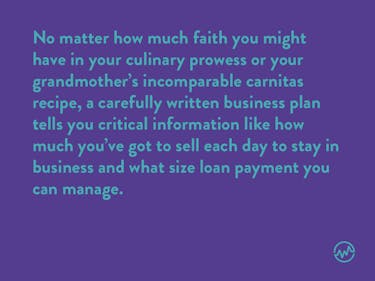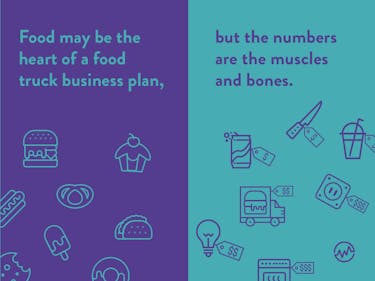

Get Access to 250+ Online Classes
Learn directly from the world’s top investors & entrepreneurs.
Get Started NowIn This Article
While the restaurant industry has steadily climbed at a yearly growth of about 2 percent in recent years, according to Foodtruckr.com, the food truck industry has EXPLODED, growing at an annual 7.9 percent over the past five years. There are multiple reasons for this growth of delicious creative eateries that operate on 4 wheels.
The food truck has several advantages over traditional brick-and-mortar restaurants, but the single most significant — especially for the newly-minted entrepreneur who lacks deep pockets — is startup cost.
A traditional restaurant can easily run $250,000 to $500,000 (or more, depending on among other things the local real estate market, the type of restaurant, and the amount of buildout required) while a food truck can often be up and running with an investment of $55,000 to $75,000 (though it is certainly possible to spend more).
In fact, it was partly the 2008 recession that kickstarted the food truck movement.
If you have a food concept that you would love to share with the public or have just always dreamed of being a restaurateur, a food truck may be just the path for you.
It is important to understand, however, that putting wheels on your restaurant doesn’t magically make the food business easier. In some very significant ways, in fact, it’s actually harder.
Having a sound, carefully prepared plan is crucial. Before we look at what needs to go into an effective plan, though, let’s take a quick look at the current state of the industry.
Food Truck Businesses Today
Today, the food truck industry continues to grow at a healthy clip, with total revenue of $800 million in 2017 expected to reach at least $985 million by the end of 2019.
These numbers are based on sales reported according to North American Industry Classification System (NAICS) codes. Other estimates put 2017 revenue as high as $2.7 billion.
The good news? The days when food trucks carried the nickname “roach coach” are mostly gone, and many consumers now look to them as a source of creative cuisine.
The bad news? There is more competition, and while competition in business is no surprise, there are secondary effects.
Some cities (New York, for example) place a cap on the number of food truck permits, so you can spend months or even years on a waiting list.
One New Orleans-based food truck entrepreneur had to lobby the city government to increase the number of permits from about a dozen to 100, along with changing ordinances that limited parking time at one location to 45 minutes and prohibited parking with 600 feet of an existing restaurant. In other words, she and her partner spent a year and a half pushing the city to reform the laws just to have the opportunity to try the food truck business under realistic regulations.
Nevertheless, the food truck industry continues to grow, and in fact its growth rate is outpacing that of the commercial foodservice industry as a whole. Another sign of the segment’s stability: Brick-and-mortar brands like Starbucks and Chick-fil-A are adding food trucks to their lineups.
Why You Need a Business Plan
Some people will tell you that you need a business plan if you hope to get a loan from a bank or other source. That is absolutely true.
However, it overlooks the most important reason for a business plan: You have to ensure that your food truck business can actually be viable.
Working through each of the components of a food truck business plan and putting pen to paper (or cursor to spreadsheet) to establish realistic revenue and expense numbers is a necessary step in determining everything from pricing to staffing.

There are really two reasons lenders want to see your business plan:
- to see whether your numbers make sense
- to ensure that you’ve put the necessary thought into the business
Let’s take a look at what you need to include in a food truck business plan to impress a loan officer and for your own planning purposes.
Food Truck Business Plan
Summary
The summary (also known as an “executive summary” if you’re feeling fancy) is simply the high-level overview of the business. This is the first thing most users of the business plan will read, and it needs to make a positive impression and be interesting while remaining concise — not always the easiest balance to strike.
However, it should actually be the last thing that you write, because it summarizes all other components of the plan, and those need to be airtight before you start this section.
The summary should cover the classic five Ws and H:
Who
Touch on your background, knowledge, and experience and explain how they will benefit the business.
What
Describe the food you’re going to sell.
When
What part of the day are you targeting? Breakfast? Lunch? Dinner? Some combination of these?
Where
Explain where your truck will normally operate, including any venues or special events you intend to target.
Why
Explain why your food and your truck will succeed in the market you’ve chosen, as well as how it differs from the competition; describe the unmet need that your truck will fulfill.
How
Summarize your key financial data, including startup costs and estimated sales and profit margins.
The summary is where your passion for your planned business should really shine through. Think of how excited you were the first time you were able to describe your fully fleshed-out concept to a friend or family member.
The only difference is that you must ensure that you present objective facts and data in support of your business case.
Business Analysis
Sometimes referred to as the “business description” or “company description,” this section essentially takes the executive summary and adds detail. It expands the “How” and describes exactly how the food truck will operate, what equipment will be needed, and where food will be sourced and prepared.
Because one of the greatest hurdles for food truck operators can be state, county, and municipal licensing and legal requirements, you should specifically discuss the statutory environment for your market or markets.
Keep in mind that if you plan to operate in two different towns, or sometimes inside the city limits and sometimes outside, you can be faced with significantly different sets of requirements and the need for multiple licenses.
It’s not necessary to specifically address staffing, marketing, or food in comprehensive detail here, because they will each be addressed in their own sections of the food truck business plan.
Owners and Team
Although you touched on your qualifications in the summary, in this section you should provide a more comprehensive description of your experience.
Think of this section as a job interview with the business plan reader and explain why you are the person who should be running this food truck. If you have a partner or partners, you need to present the same information for them.
Also, if more than one owner will be involved, delineate who will have what responsibilities.
For example, if you’re the culinary genius, perhaps you’ll be handling menus and food sourcing while your partner deals with accounting, administration, and regulatory compliance.
You should also describe the company’s legal entity, which includes
- name
- type
- state of formation
- disclose the ownership percentages.
If you have owners who are contributing money but will not be actively involved in the management of the business, you should note them as one of the following:
- passive partners
- shareholders
- members
If you intend to have employees, this section should address how you will staff the truck, as well as discussing pay and benefits.
Because many jurisdictions below the state level have been pushing independent minimum wage initiatives, it is important to address how planned wage increases will impact your labor costs — something that should be reflected in your financial projections as well.
Product Description
In many ways this is the heart of your food truck business plan, because the food you plan to sell is what will drive the success or failure of your truck.
You should include the most enticing, mouth-watering descriptions of your products here, because while the numbers do matter, lenders and investors want to understand and appreciate what you’re going to sell (and why you think it will succeed, which is addressed in the next section).
This is the place to talk about why you’re passionate about this particular kind of food, how it originated, and the genre or cuisine to which it belongs.
If you are already selling your food through other channels, present hard data on how your products have been received by customers.
If you’ve made tweaks to your recipes or presentation based on customer feedback, you should definitely discuss that as well since it demonstrates that your food has already proved itself in the marketplace.
Market Analysis and Sales Strategy
This is where you show off all the market research you’ve done to determine whether your food truck has a good chance of being viable.
In this section, it’s important to discuss:
- the size of your potential market
- what time of day you’ll be operating and days of the week
- alternate locations
- seasonality
- how you plan on utilizing your online presence
If you’re going to set up in the heart of your city’s central business district Monday through Friday for breakfast and lunch, great, but do you plan to operate in the evenings and/or on the weekend? If so, will that be at an alternate location?
You should also present an analysis of your competition. Explain how you intend to compete.
Can your food be prepared more quickly than theirs?
Will you compete based on price?
Do you have a cuisine that isn’t represented by current offerings in your chosen market?
What will happen if an imitator decides to set up shop when they see your success?
Regarding your specific marketing strategy, include photos or drawings of your truck fully decked out with logos and paint scheme.
Add samples of any marketing materials you’ve designed, such as menus, brochures, flyers, or catering kits.
Discuss what marketing channels you will use and what the estimated costs are for each. If you are planning some sort of loyalty program, include that information as well.
Required Funds
This section will vary based on your specific food truck business plan.
There are two main users of business plans:
- lenders
- investors
The required funds analysis should show total funds required (for startup costs and working capital until the business reaches breakeven) and where you expect to generate them.
Lenders normally want to see that you have “skin in the game” and are unlikely to fund your entire requirement.
You’ll need to explain the source of your own capital contribution. If you are presenting your plan to investors, don’t put your hope in a single one providing the entire amount that you need, so it’s helpful to provide sample funding levels.
Anyone lending or investing will want to know how they’ll be paid back, of course.
If you’re addressing potential lenders, you should include proposed basic loan terms reflecting what you used in your financial projections (for example, a seven-year amortization at 6.5% interest).
Be aware that you’re unlikely to get loan terms (you may be required to sign a personal guarantee) longer than seven years for a food truck, so be realistic with your expectations.
If you’re addressing potential investors, explain how and when they will be repaid and what they’ll receive over and above their invested principal.
If you decide to not use lenders or investors, read further about bootstrapping — using your own funds or revenue to fund your business — here. Remember that even if you do elect a different funding option, it’s still important to get a food truck business plan on paper to help organize and scale the business.
Financial Projections

You’ll need two basic sets of numbers for your plan:
- startup costs
- operating projections
The startup costs include what will be required to buy and equip the food truck along with all the ancillary expenses involved with getting the business up and running, such as required permits and licenses.
The operating projections typically cover the first three years; you may occasionally be asked for five years, but that’s unusual, especially for a new business since there are so many variables that are difficult to predict looking so far into the future.
The foundation of your financial projections is your revenue estimate. Your market research should have given you an idea of how many customers per day you can serve in your chosen location and operating hours, along with what they’re likely to purchase. Say for example that you plan to run a taco truck, and your research shows that the typical customer will buy three tacos plus a drink.
The next component is cost of sales (COS) or cost of goods sold (COGS). This is primarily your ingredients and paper.
It is appropriate to include labor costs as well if you so choose (which is what produces COS instead of COGS); some restaurant brands do, and others don’t. Of course, if you don’t plan to have employees initially, that will be a non-issue for your plan.
Revenue less COS or COGS gives you gross profit.
To arrive at net profit, you have to deduct all of your other expenses. These come in three categories:
- fixed
- variable
- semi-variable
COGS is the main variable cost, as it will increase in direct proportion to sales. Labor is a good example of a semi-variable cost; sales have to increase a certain amount before it’s necessary to add another employee. Fixed costs include things like insurance that don’t change from month to month.
Determining revenue will be the hardest part of your financial projections. Once you have developed your menu, you can use information from potential suppliers to determine the build cost for each menu item — that is, how much each one costs to make.
Estimate your product mix (how much of each item you will sell) using your market research, and then adjust your item prices until you arrive at a reasonable profit margin.
Other Food Truck Tips
There are certain challenges that are either unique to the food truck business or far more significant than for other businesses.
Licensing
First, as already mentioned, the regulatory and licensing environment can be punishing. Local ordinances can make even finding a place to legally park your food truck a challenge.
Food trucks have to comply with all of the health codes that affect brick-and-mortar restaurants and then some.
For example, the Los Angeles County Health Department (LACHD) requires a food truck is parked in one spot for more than an hour to have access to a restroom within 200 feet. However, Los Angeles County contains 88 separate municipalities, and three of those have their own health departments that supersede LACHD. (You can learn more about the intricacies of licensing a food truck in Los Angeles County here. Even if you will not be operating there, this will give you some insight into just what can be required for compliance.)
Access To A Kitchen
Second, depending on the food you plan to serve, you may need access to a commissary kitchen instead of being able to prepare your product from start to finish in the truck.
Ingredient storage will be limited, so you will need to either secure access to storage elsewhere or be prepared to make frequent runs to buy food.
Mechanical Issues
Third, food trucks are trucks, and all the mechanical issues that can affect any vehicle are liable to strike your food truck.
It’s particularly painful to be broken down on the side of the road when you should be set up at a site and selling, so the more repair work you can do yourself, the better off you’ll be.
It’s also important to realize that these trucks don’t get great mileage, so fuel can be a significant expense depending on how often you move and over what distances.
Food Truck Business Plan
The food truck can be a great alternative to a traditional restaurant and a significantly less expensive way to break into the business. The industry continues to grow and is clearly not going away.
Still, there are unique challenges that must be overcome to be successful in the food truck business.
Having the right food truck business plan is the best way to start.






